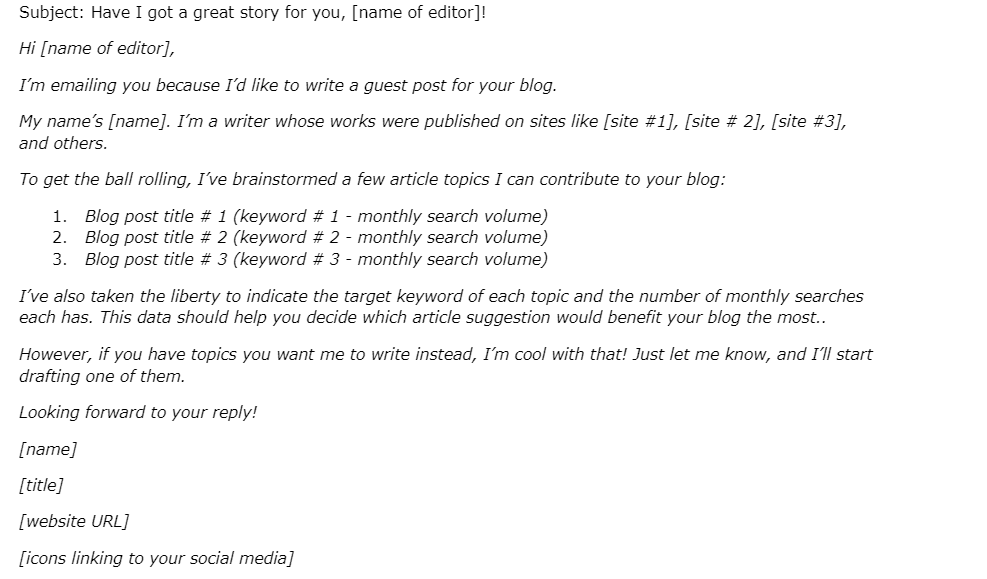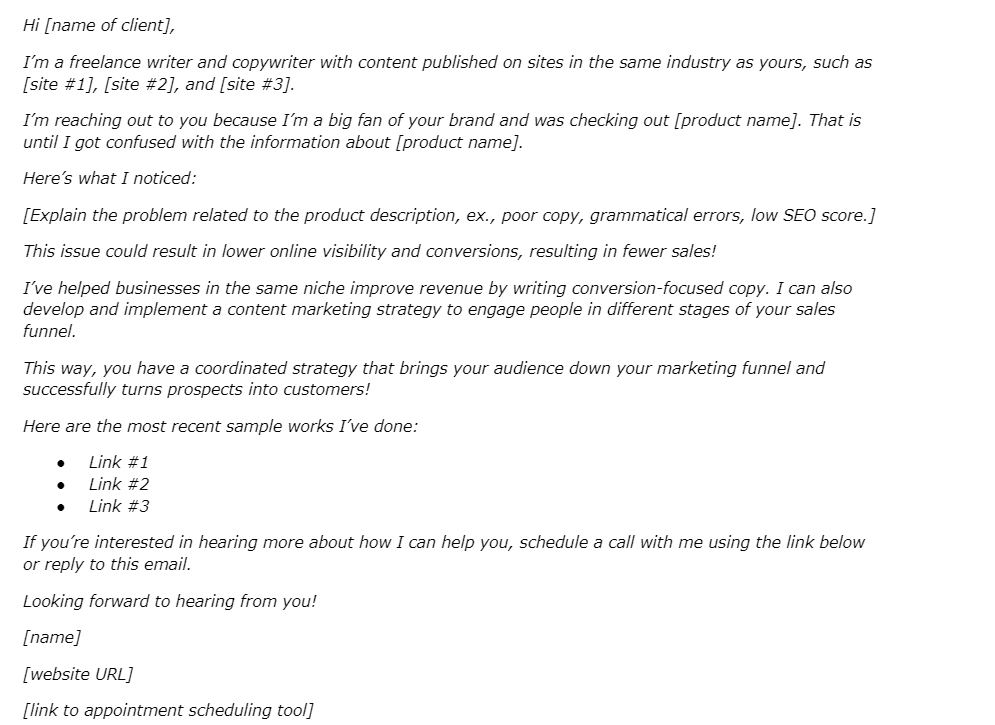How to Write a Pitch [Tips, Examples & Mistakes to Avoid]
The problem with writing pitches is there are no guarantees that people will respond to them no matter how long and hard you worked on them.
But what if we tell you there’s a surefire way to write pitches with increased chances of getting a positive reply from your prospects?
This post discusses the best practices you should observe and common mistakes to avoid when writing a successful pitch. We’ll also share some templates you can use and edit with your details for your outreach campaign.
So, keep reading if you want to learn the above!
What is a Pitch?
Generally, a pitch is an email message proposing a business idea or opportunity to prospects that could benefit both parties.
It is an outbound lead generation strategy that serves different purposes. If you’re reaching out to bloggers and editors to write a guest post on their website, you can send an email pitch presenting topics that haven’t been published on their blog yet and is suitable for their audience.
The same concept applies if you want to secure a backlink from your prospect’s website. You want to give them something good if you want them to link to your site on one of their pages. Examples include giving a discount on your product (if not a lifetime account) or an occasional link exchange proposal, among others.
But if you want a prospective client to hire you as a writer, you must present a convincing case of why you’re the right person for the freelance writing job.
This leads us to the next point.
5 Tips to Write an Effective Pitch
All pitches have the same goal: to get recipients to accept your idea and set the wheels in motion.
There’s a science to writing pitches that produce this result, and below are tips that lay the groundwork for this to happen.
Tip #1: Know your target
Emails that address recipients as “Sir/Madam” don’t fare well due to how impersonal they are. Also, such intros often indicate an email template, which lazy marketers sometimes use to reach out to prospects. Needless to say, it’s absolutely unacceptable from a professional standpoint.
Essentially, knowing who your target is means knowing their name—a quick look at their websites or LinkedIn profiles should show you this.
Also, sending your message straight to the recipient’s professional email (not their personal one) allows you to reach them directly with your email pitch. The same applies to sales pitches.
To find your prospect’s best email address, you can use email finder tools like Hunter.io that allow you to scrape the contact information your prospect is most likely using. Using this software, you can also create a lead list of prospects sharing the same characteristics.
Apart from that, these tools give you an overview of the recipient’s work and position in the organization, which you can use in your pitch letter.
Tip #2: Pay attention to your subject line
To get people to click on your pitch, a compelling email subject line is in order. Below are techniques you can use:
- Keep it short – ideally, no longer than eight words.
- Mention their name – it will make them curious about opening your email.
- Address their pain points directly – mention the difficulties they’re having relevant to your pitch, ex., “Joe, here’s an article idea to help grow your site’s traffic…”
- Namedrop the person who recommended them to you – this allows you to establish trust with recipients and turns a cold pitch into a warm one, ex. “Jenny told me you’re looking for a writer?”
- Keep it formal – don’t go for needy, click-bait subject lines that underdeliver on their initial promise.
If they open your email because of your subject line, it means you already have the reader’s attention. Take advantage of this by following the next tip.
Tip #3: Get to the point (cut the fluff 😉)
Think of your email as an elevator pitch. Since you’re dealing with busy people, you want to go straight to talking about your idea.
A common issue most marketers make is using the first few sentences to introduce who they are. While this is fine in most cases, don’t spend too much time talking about yourself (more on this later).
Even better, use the signature section of your email for your name, position, social media links, and relevant clips of her work as a digital marketing freelancer, for instance. This allows you to keep your pitch short so as not to waste your prospects’ time.
Also, make sure not to include fluff in your pitch. As mentioned, don’t talk about yourself or the company you work for. To be blunt, prospects don’t care about who or what you are, as they’re more interested in knowing your offer.
Basically, don’t include anything that doesn’t have to do with helping your prospects.
After all, if they’re interested in learning more about you, they will click on the links in your signature.
Tip #4: Highlight what’s in it for them
While you’re sending the pitch to gain something from it, you can’t achieve this if you don’t provide value to your prospects. So, explain how your idea will benefit them in the long run. This is called a pitch deck – a brief overview proving your value to a potential client.
To do this right, you must know each of your recipients and their respective pain points.
Below are examples of pain points you must address in your pitch depending on what your purpose is for reaching out to prospects:
- Building links – their site isn’t getting lots of organic traffic or needs content they haven’t covered before that will engage their readers.
- Securing clients – they want someone who can do a set of tasks for them so they can focus on more important matters regarding their business.
- Partnering with influencers who will promote your business – they want to create content for their audience by featuring products and services they’re interested in.
- Getting featured in their podcast – they are looking for stories relevant to their listeners to help mobilize them into action.
- Asking them to write a review about your product – they want new and exciting products to talk about on their site.
Your pitch should help solve some of their issues—if not all—to increase your chances of getting a response from them.
Tip #5: Make it easy for them to follow up
Before sending your article pitch to prospects, check if they have guidelines for pitch submissions. Following them should help recipients get back to you at the earliest.
If not, you must make replying to you easier for them. Here’s how to achieve it.
Aside from your email address, indicate other ways they can reach out to you. For instance, display your phone number and include links to your messenger (Skype, Whatsapp, etc.) in the signature.
Another good idea is to add a link to your appointment scheduling software if they want to discuss your idea in person.
Now, even if you’re aware of the basics of writing compelling pitches, there’s still a slight chance you might make costly mistakes affecting the possibility of a reply.
5 Mistakes to Avoid when Writing Your Pitch
Just as much as you need to know tips to help make your pitch better, you also must be aware of practices to avoid. Below are the most common mistakes that are present in most bad pitches.
Mistake #1: Ignoring guidelines
As mentioned, you must follow the site’s editorial guidelines when sending your pitch. You can find this information on their website or try Googling “submission guidelines: [name of publication].”
Some of them would require you to write something in the headline or message body so that they know you’re paying attention. This also helps them filter pitches that follow directions.
If the site doesn’t have guidelines for submitting pitches, just write the best email that you can. There are templates in the next section that you can swipe and edit to help improve the visibility of your pitch.
Mistake #2: Focusing too much on your bio
The pitch is about how you can help editors solve their pain points or provide value to their audience, not about who you are.
While they want to know about your credentials and skills concerning your idea, they don’t want to hear it throughout your pitch. So, don’t turn it into a memoir.
While it’s advisable not to stuff the email with personal details and leave them for the signature section, it’s important to provide your viewpoint on how the recipient’s problem can be solved. You can add screenshots, attach reports, etc. Content writers can also link back to the samples of their work to showcase their skills and value.
Mistake #3: Showing lack of confidence
Closing prospects with your pitch without samples or direct experience is still possible. But this only works as long as you assure them that you’re the right person for the job or if you have a referral from someone they know.
To add credibility to your email, explain how you intend to execute your pitch. This way, you show prospects that you know what you’re talking about, increasing their trust in you.
You can elaborate on your plan of action once they reply to your pitch.
Mistake #4: Using the same pitch for every recipient
Editors and clients have different needs and audiences, so you can’t send the same pitch and expect good results from it.
Personalize the pitch you send to each prospect by mentioning their name and addressing their pain points. It’s also a good idea to go through their LinkedIn profiles, pick up their interests, and address them in your message. For instance, it can be a recent post, an article they published, or a comment they left under someone else’s publication.
Apart from that, look for something that would connect their interests and yours. This way, you create a bond that can potentially lead to a fruitful ongoing collaboration.
Mistake #5: Attaching documents
Emails from unknown senders with attachments are never good. It’s best not to open these to protect your device from malware.
So, even if you have no malicious intent by attaching a file describing your idea, it’s best to send it without attachments. Once the prospect expresses their interest, you can go ahead and send the files over. Besides, adding the files in your first pitch would give away the best of your idea, and you want to build suspense.
Examples of a Good Pitch
Now, to help you get an idea of the kinds of pitches that work, we’ve put together tried-and-true pitch templates you can swipe and edit as you please. Our examples serve different purposes – article submission and client pitch for freelancers.
Note – if you make any changes to these templates, make sure to run a quick grammar check to eliminate any embarrassing mistakes – you don’t want to appear unprofessional.
Example #1: Article / blog post submission pitch

What makes this template a good pitch:
- Ths pitch example doesn’t beat around the bush and goes straight to the point.
- A one-sentence description of yourself and the latest articles you’ve written on different sites is sufficient to prove your expertise.
- Suggesting topics to write about shows your proactiveness.
Example #2: Client pitch for freelance writers

What makes this template a good pitch:
- It goes heavy on personalization to help you land better full-time writing gigs.
- This freelance pitch template works even if you’re not really a fan of the brand. Just spot a potential issue on their website and offer your writing services as a solution.
- It has a clear call to action to encourage the readers to get back to you.
While these templates should help you get the ball rolling with your pitch, you still have to implement more advanced tips to maximize their conversions, which is crucial in all email marketing-related campaigns. Speaking of which…
3 Advanced Tips on Writing a Top Pitch
If you want to take your pitch to the next level by increasing its response rate, below are high-level tips you must take heed of.
Tip #1: Research is your secret weapon
As part of knowing who the recipient of your pitch is, you must research their site’s style and tone of voice, target audience, and topics they’ve covered in the past and must cover in the future, among others.
The information allows you to personalize your pitch and compel them to reach back to you regarding your offer.
Tip #2: Explain why you’re the best fit
Let’s face it: they can easily use the information you shared in your pitch and assign it to someone else in their organization. That’s why we mentioned that it’s not a good idea to give all details of your offer straight away.
But then, how can you prove that you’re the right fit?
Consider sharing your professional background, credentials, and links to published works and achievements – anything you have to show your worth.
By presenting irrefutable proof of your skills, you can convince them that you’re the only one who can pull off the ideas you proposed in your pitch and no one else.
Tip #3: Use a catchy hook
The hook is a statement that appears just before your actual pitch and answers any of these questions:
- Does it spark their interest?
- Does it stroke their ego?
- Is it a legitimate problem on their website and points at you as the solution?
The statement lays the foundation for your idea and paves the way for the recipient to become receptive to your pitch.
Now Over to You
Developing a high-converting pitch involves a lot of moving parts. Let’s sum them up as a recap:
- Knowing who your target is is crucial to crafting a subject line that people will click on and writing a pitch that goes straight to the point by clearly communicating your value proposition.
- Always follow the site’s editorial or pitch submission guidelines (if they have one). Also, customize the pitch you’ll be sending to each prospect, don’t attach a file to it, and focus on what you can do for them instead of talking about who you are. Finally, they will only agree to your pitch if you show how confident you are in your abilities to get the job done.
- Even if this is your first time writing a pitch, the templates above should make things much easier for you. Just edit each one according to your prospect’s information to get your desired results.
Have you found this guide helpful? Make sure to check out more content pieces on our blog – we cover the topics of lead generation, digital marketing, social media, and more.

Christopher Jan Benitez is an accomplished content writer and a contributor at Digital Marketer’s World. He specializes in content marketing, Search Engine Optimization, and web marketing.
